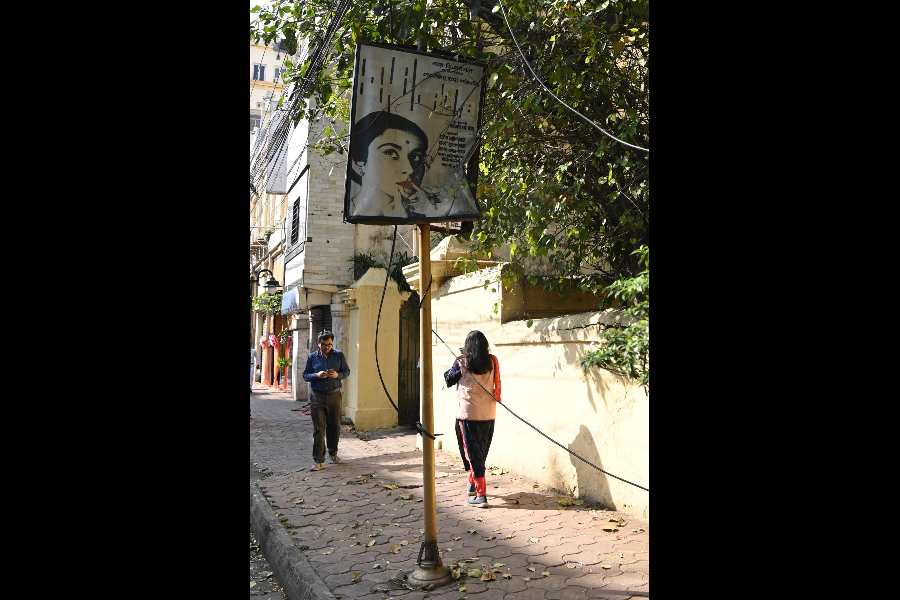A beautified Bishop Lefroy Road, where Satyajit Ray lived and worked, was inaugurated by chief minister Mamata Banerjee with much fanfare in March 2016.
Replicas of film posters designed by the master adorned the 240m stretch, interspersed with 22 Victorian-era, cast-iron lampposts painted in black and gold.
Eight years down the line, the street cuts a sorry picture.
The posters are mostly shredded. Some of them have all but come off. None of the lampposts works, local people said. The lights are missing from some.
In the middle of the road, a poster of Sonar Kella (1974) can hardly be read. Half of the poster has come off. The faces of Feluda and Jatayu are visible but the part showing the principal antagonist, the fake Dr Hazra played by Ajoy Banerjee, was barely hanging from the poster board when this newspaper walked the stretch on Friday.
The spot right under the poster looked like a dumpyard with waste in black plastic packs piled on the road.
Crumpled and torn was the poster for the 1989 film Ganashatru (based on Henrik Ibsen’s 1882 play An Enemy of the People), showing fingers pointing at the protagonist, Ashoke Gupta (a doctor played by Soumitra Chatterjee). The fingers represent people who declared the doctor a heretic for saying the “sacred water” of a temple was polluting the area and killing people.
The board with the poster for Mahanagar (The Big City), the 1963 film on the quest for a respectable existence in 1950s Calcutta, was dented on one side. The photographic poster features what is probably the most memorable image from the film, one where Madhabi Mukherjee’s Arati applies lipstick for the first time.
Lallu Tewari, the watchman of a majestic but decrepit three-storey building on Bishop Lefroy Road, has been a resident of the neighbourhood for over three decades. “The decorations were done long ago. But with time, everything fades away. Now, none of the lights works,” said Tewari.
A tailor on the same road said that while the pavements are cleaned regularly, the lampposts and the posters are not maintained.
1/1 Bishop Lefroy Road was Ray’s home from the 1970s till he died in 1992. He made the Calcutta Trilogy (Pratidwandi, Seemabaddha and Jana Aranya), the two Feluda classics and memorable films like Hirak Rajar Deshe, Ghare Baire, Ganashatru, Shakha Proshakha, Ashani Sanket and Agantuk while living in the second-floor apartment.
Eight years ago, an elaborate function marked the inauguration of the decked-out road. The beautification was done by the Calcutta Municipal Corporation. Besides Mamata, the then mayor of Calcutta, Sovan Chatterjee, was present. As were Ray’s son Sandip, Ray’s actors Barun Chanda and Madhabi Mukherjee, and the local councillor.
At the programme, Mamata “requested” the civic body to rename the adjacent Lee Road — which connects AJC Bose Road and Elgin Road — after Ray. One end of 1/1 Bishop Lefroy Road, a corner plot, is on Lee Road.
But instead of Satyajit Ray Sarani, she wanted the road named Satyajit Ray Dharani. “Dharani” means “the earth”.
A signboard saying “Satyajit Ray Dharani” stands at the intersection of Lee Road and Bishop Lefroy Road.
Ashim Basu, the local Trinamul councillor (of Ward 70), said he was aware of the condition of the Ray posters and lampposts. An extensive repair job would be done soon, he promised.
“The contract has already been given. Work should start soon. Once the work is complete, the stretch will look better than ever,” Basu told this newspaper on Friday.
He blamed “junkies and vagabonds” for some of the missing lights.
Mudar Patherya, a communications consultant who has been instrumental in painting CESC transformers and feeder boxes to celebrate the famous residents of those neighbourhoods, said upkeep was a continuous process.
“When you are celebrating an international icon like Ray, you should either give due focus on maintenance, otherwise you should not go for beautification at all.... It represents a defeat for the city itself,” he said.
One wonders how the master himself would have reacted, given that he was passionate about the city’s heritage.
His story, Gorosthane Sabdhan, describes in Topshe’s word how Feluda has developed an interest in the origins of road names after learning that Fancy Lane got its name from the hanging (phansi in Bengali) of Maharaj Nandakumar.
The Rays declined to speak.
